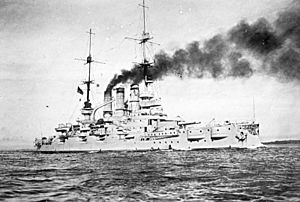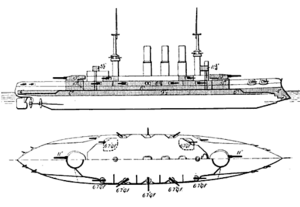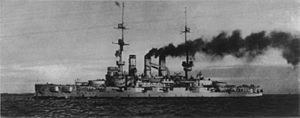SMS Pommern facts for kids

SMS Pommern in 1907
|
|
Quick facts for kids History |
|
|---|---|
| Name | Pommern |
| Namesake | Pomerania |
| Builder | AG Vulcan, Stettin |
| Laid down | 22 March 1904 |
| Launched | 2 December 1905 |
| Commissioned | 6 August 1907 |
| Fate | Sunk by British destroyers at the Battle of Jutland, 1 June 1916 |
| General characteristics | |
| Class and type | Deutschland-class battleship |
| Displacement | |
| Length | 127.6 m (418 ft 8 in) |
| Beam | 22.2 m (72 ft 10 in) |
| Draft | 7.7 m (25 ft 3 in) |
| Installed power |
|
| Propulsion |
|
| Speed | 18 knots (33 km/h; 21 mph) |
| Range | 5,830 nmi (10,800 km; 6,710 mi) at 10 knots (19 km/h; 12 mph) |
| Complement |
|
| Armament |
|
| Armor |
|
SMS Pommern was a large warship called a pre-dreadnought battleship. She was one of five ships in the Deutschland-class class built for the German navy between 1904 and 1906. The ship was named after a German region called Pomerania.
Pommern was built at the AG Vulcan shipyard in Stettin, Germany (which is now Szczecin, Poland). Her construction started on March 22, 1904, and she was launched into the water on December 2, 1905. She officially joined the navy on August 6, 1907. This battleship was armed with four large 28 cm (11 in) guns and could travel at a top speed of 18 knots (33 km/h; 21 mph). However, by the time she was ready for service, new, more powerful battleships like the British HMS Dreadnought had already been built. These new ships were bigger, had stronger armor, more powerful guns, and were faster, making Pommern and her class already a bit old-fashioned.
After joining the navy, Pommern became part of the High Seas Fleet's Second Battle Squadron. She served there during peacetime and for the first two years of World War I. Before the war, the fleet often went on cruises and practiced battle strategies. When the war began, Pommern and her squadron helped defend the German coast in the German Bight. They also took part in several missions into the North Sea, trying to draw out and fight parts of the British Grand Fleet.
These missions led to the major naval battle known as the Battle of Jutland, which happened from May 31 to June 1, 1916. During the battle, Pommern and her sister ships briefly fought British battlecruisers. Pommern was hit by a shell from the British battlecruiser HMS Indomitable. Later, in the early morning of June 1, she was hit by one or two torpedoes from the British destroyer HMS Onslaught. These torpedoes caused a huge explosion in one of Pommern's ammunition storage areas. The explosion broke the ship in half, and it sank, killing everyone on board. Pommern was the only battleship from either side to be sunk during the Battle of Jutland.
Ship Design and Features
In 1900, a new law was passed in Germany, thanks to Vice Admiral Alfred von Tirpitz. This law provided money to build twenty new battleships over the next seventeen years. The first group of these ships was the Braunschweig-class battleship class. Soon after, work began on a new design, which became the Deutschland class class. The Deutschland-class ships, including Pommern, were similar to the earlier ships but had slightly better armor. They also changed how their smaller guns were placed, moving them into special armored rooms called casemates instead of turrets, which saved weight.
However, a big change happened in naval design when the British battleship HMS Dreadnought was launched in December 1906. This ship was armed with ten 12-inch (30.5 cm) guns and had a completely new design. Dreadnought was so advanced that it made all older battleships, including the Deutschland class, seem outdated.
Pommern was about 127.6 meters (418 ft 8 in) long. She had a width (beam) of 22.2 meters (72 ft 10 in) and sat 8.21 meters (26 ft 11 in) deep in the water. When fully loaded, she weighed about 14,218 metric tons (13,993 long tons). The ship was powered by three triple-expansion steam engines, which used steam from twelve Schulz-Thornycroft boilers. These boilers burned coal, and the smoke went out through three funnels.
Pommern could reach a top speed of 18 knots (33 km/h; 21 mph). During her trials, she actually went even faster, making her the quickest ship in her class. She was also very fuel-efficient. At a cruising speed of 10 knots (19 km/h; 12 mph), she could travel about 5,830 nautical miles (10,800 km; 6,710 mi). Her crew included 35 officers and 708 enlisted sailors.
Pommern's main weapons were four 28 cm (11 in) SK L/40 guns, placed in two twin turrets (one at the front and one at the back). For smaller targets, she had fourteen 17 cm (6.7 in) SK L/40 guns, each in its own casemate. To defend against small, fast torpedo boats, she carried twenty-two 8.8 cm (3.5 in) SK L/45 guns. The ship also had six 45 cm (17.7 in) torpedo tubes, which were hidden underwater in the hull. One was at the front, one at the back, and two on each side.
The ship was protected by strong Krupp cemented armor. Her main armored belt, which protected important areas like the engine rooms and ammunition storage (magazines), was 240 mm (9.4 in) thick in the middle. The deck armor was 40 mm (1.6 in) thick, and the main gun turrets had 280 mm (11 in) of armor plating.
Service History
Pommern was built at the AG Vulcan shipyard in Stettin. She was supposed to be launched in November 1905, but the water in the harbor was too low. So, she was finally launched on December 2. After her launch, she was moved to Kiel in July 1907 to have her main guns installed. She began her trials on August 6 and proved to be very fast, reaching 19.26 knots (35.67 km/h; 22.16 mph). This made her the fastest pre-dreadnought battleship in the world at that time.
Pommern joined the Second Battle Squadron of the High Seas Fleet. She took part in many training exercises and cruises in the Baltic Sea and North Sea. In July 1908, Pommern and the rest of the fleet sailed into the Atlantic Ocean for a big training cruise. This was meant to prepare the fleet for operations far from Germany. The fleet returned in August, followed by more training exercises.
The next few years followed a similar pattern of training and cruises. In 1909, the fleet went on another Atlantic cruise and was even greeted by the British Royal Navy in Spithead. In 1910, the fleet moved its main base from Kiel to Wilhelmshaven. They also practiced maneuvers in the Kattegat, a sea area between Norway and Denmark. The annual summer cruise often went to Norway.
In March 1911, the fleet trained in the Skagerrak and Kattegat. Pommern and the fleet also hosted British and American naval groups in Kiel. In 1912, because of a political problem called the Agadir Crisis, the summer cruise stayed in the Baltic Sea to avoid any trouble with Britain and France. Pommern also participated in celebrations for the 50th anniversaries of events from the Second Schleswig War.
World War I
In July 1914, just before World War I began, Pommern was on her annual summer cruise to Norway with the High Seas Fleet. Due to rising tensions, the cruise was cut short, and the fleet returned to Wilhelmshaven by July 29. On August 4, the United Kingdom declared war on Germany. Pommern remained with the High Seas Fleet for the first two years of the war.
At the start of the war, the German navy placed the Second Squadron, including Pommern, in the German Bight. Their job was to defend Germany's coast from a possible attack by the Royal Navy. Pommern and her squadron were stationed at the mouth of the Elbe River to support patrol ships.
Once it was clear that the British would not launch a direct attack on the main German fleet, the Germans began to plan operations to try and lure out smaller parts of the British Grand Fleet and destroy them. This way, they hoped to make the forces more even before a big battle. Pommern and her squadron joined the High Seas Fleet to support German battlecruisers that bombarded British coastal towns like Scarborough in December 1914. The main fleet stayed further back as support. During this mission, the German fleet came close to some British battleships, but the German commander decided to turn back, fearing the entire Grand Fleet was nearby.
There were several more fleet advances in 1915 and 1916 that did not lead to major battles. On April 24–25, 1916, Pommern and her sister ships again supported battlecruisers raiding the English coast. One battlecruiser, Seydlitz, was damaged by a naval mine and had to return home. The other ships briefly bombarded Yarmouth and Lowestoft before the mission was called off.
Battle of Jutland
The new commander of the High Seas Fleet, Vice Admiral Reinhard Scheer, planned another mission into the North Sea. This mission was delayed until the end of May because Seydlitz was being repaired. On May 31, at 2:00 AM, German battlecruisers sailed out, followed by the rest of the High Seas Fleet about an hour and a half later. Pommern was still part of the Second Battle Squadron, which was at the very back of the German battle line.
During the battle, the slower Deutschland-class ships, including Pommern, could not keep up with the faster dreadnoughts. By 7:30 PM, the British Grand Fleet had arrived, giving them a much larger number of ships. The slower German ships made it harder for Scheer to maneuver. If he turned the fleet around quickly to escape, he might have to leave the slower ships behind.
Scheer decided to turn the entire fleet around at the same time. Because the Second Battle Squadron had fallen behind, they ended up on the side of the German line that was not facing the enemy. The squadron commander thought about moving his ships to the back of the line but decided against it to avoid getting in the way of the battlecruisers. Instead, he tried to move them to the front.
Later that evening, the German battlecruisers were being chased by British ships. Pommern and her sister ships, sometimes called "five-minute ships" because they were older, came to help. They sailed between the two groups of battlecruisers. Pommern could not see a target in the dark, but some of her sister ships could, though their shots did not hit anything. The British battlecruisers did hit some German ships, including Pommern. She was hit by a 12-inch (30.5 cm) shell from Indomitable, which forced her to move out of the battle line.
At 3:10 AM on June 1, Pommern was hit by torpedoes from the British destroyer Onslaught. At least one, and possibly two, torpedoes struck the ship. This caused a massive explosion in one of her 17 cm (6.7 in) ammunition magazines (storage areas). The explosion was so powerful that it broke the ship in half. The back part of the ship flipped over and stayed afloat for about 20 minutes with its propellers sticking out of the water. The ship behind Pommern, Hannover, had to quickly move to avoid hitting the sinking wreck.
All 839 officers and sailors on board Pommern were killed when the ship sank. She was the only battleship, old or new, from either side to be sunk at Jutland. Because of her loss and the weaknesses of the other older battleships, Admiral Scheer decided to leave them behind in future missions. The decorative bow ornament from Pommern, which had been removed at the start of the war, is now kept at the Laboe Naval Memorial in Germany.




